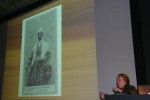National Abolition Hall of Fame

In 1865, the Thirteenth Amendment abolished slavery. Today, the National Abolition Hall of Fame (NAHOF), in partnership with the Upstate Institute at Colgate University, honors antislavery abolitionists and works to complete the enduring “Second Abolition” of discrimination and racism.
Last weekend, NAHOF held its Second Induction Ceremony by admitting John Brown, Lydia Maria Child, Wendell Phillips and Sojourner Truth. These four exemplary figures, chosen for their dedication to achieve equal rights for all people, joined Frederick Douglass, William Lloyd Garrison, Lucretia Mott, Gerrit Smith and Harriet Tubman, the first class of inductees who were admitted to NAHOF in 2005.
The weekend’s events, started on Friday the 19th with a screening of Amazing Grace in Little Hall. On Saturday, James Brewer Stewart held a book signing for his introduction to the abolition movement, Holy Warriors.
On Saturday at 1:00 pm, NAHOF held the Inductee Symposia in Little Hall. After a welcome from senior NAHOF Fellow Ayanna Williams, Professor of Geography at Colgate and Director of the Upstate Institute Ellen Kraly spoke about the organization’s goals. The Upstate Institute aims to link Colgate to the regional community by researching and transferring knowledge to enhance the capacity and beauty of the area.
“Through partnership, everyone wins,” Kraly said.
Various speakers then gave presentations on the four inductees, highlighting their critical roles in abolition as well as their relevance to today’s society. Dr. Louis DeCaro, Jr. debunked common myths about John Brown, the man who organized the attack on the U.S. arsenal at Harpers Ferry in 1859, sparking the Civil War.
“We all owe John Brown another look,” DeCaro said, explaining that contrary to popular belief, Brown was not a “misanthrope, a lunatic, or a terrorist.”
Syracuse University doctoral student Corinne Martin focused on author Lydia Maria Child’s anti-slavery literature.
“[She] broke barriers both within and without the women’s sphere,” Martin said.
James Brewer Stewart, professor at Macalester College, raised an interesting question as he discussed orator Wendell Phillips’ contributions to the abolition movement: Who abolished slavery, and did the abolitionists really have anything to do with it? Comparing Phillips’ popularity to that of Bono and Sting, Stewart aptly conveyed Phillip’s charisma and sense of “physical, intellectual, and moral power.” Former Executive Director of the National Women’s Hall of Fame Billie Luisi-Potts then spoke about Sojourner Truth’s “extraordinary moral agency,” highlighting her differences from the other three inductees.
The Saturday night Induction Ceremony included musical selections from the Hamilton Central Upper School chorus and an organist from Hamilton First Baptist Church, where the ceremony was held. There were also monologues about each inductee performed by Colgate Theater students, including sophomore Christine Gayles’ presentation of Sojourner Truth’s “Ain’t I a Woman?”
Sunday’s events were held in Peterboro, the site of the future NAHOF and Museum.
Senior NAHOF Fellow Lydia Gottesfeld was very pleased with the turnout of Colgate students and Hamilton residents to all of the events.
“NAHOF is so important in getting the message across that slavery was a time in America that we cannot forget,” Gottesfeld said. “It has shaped the way that an entire people in our population functions. The legacy of slavery lives on.”
For more information regarding the Upstate Institute and NAHOF, please visit their website http://upstate.colgate.edu or at www.abolitionhof.org.






